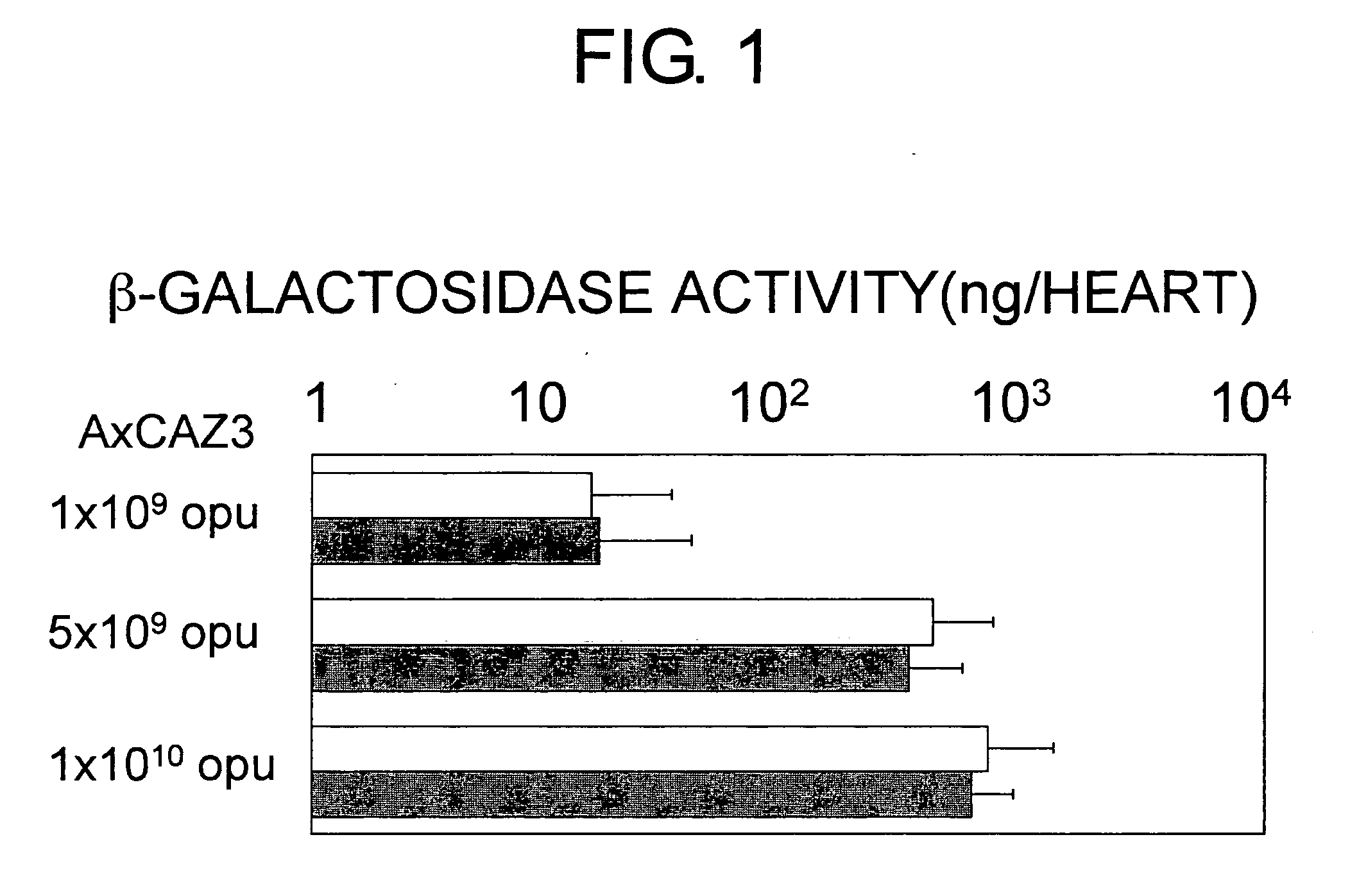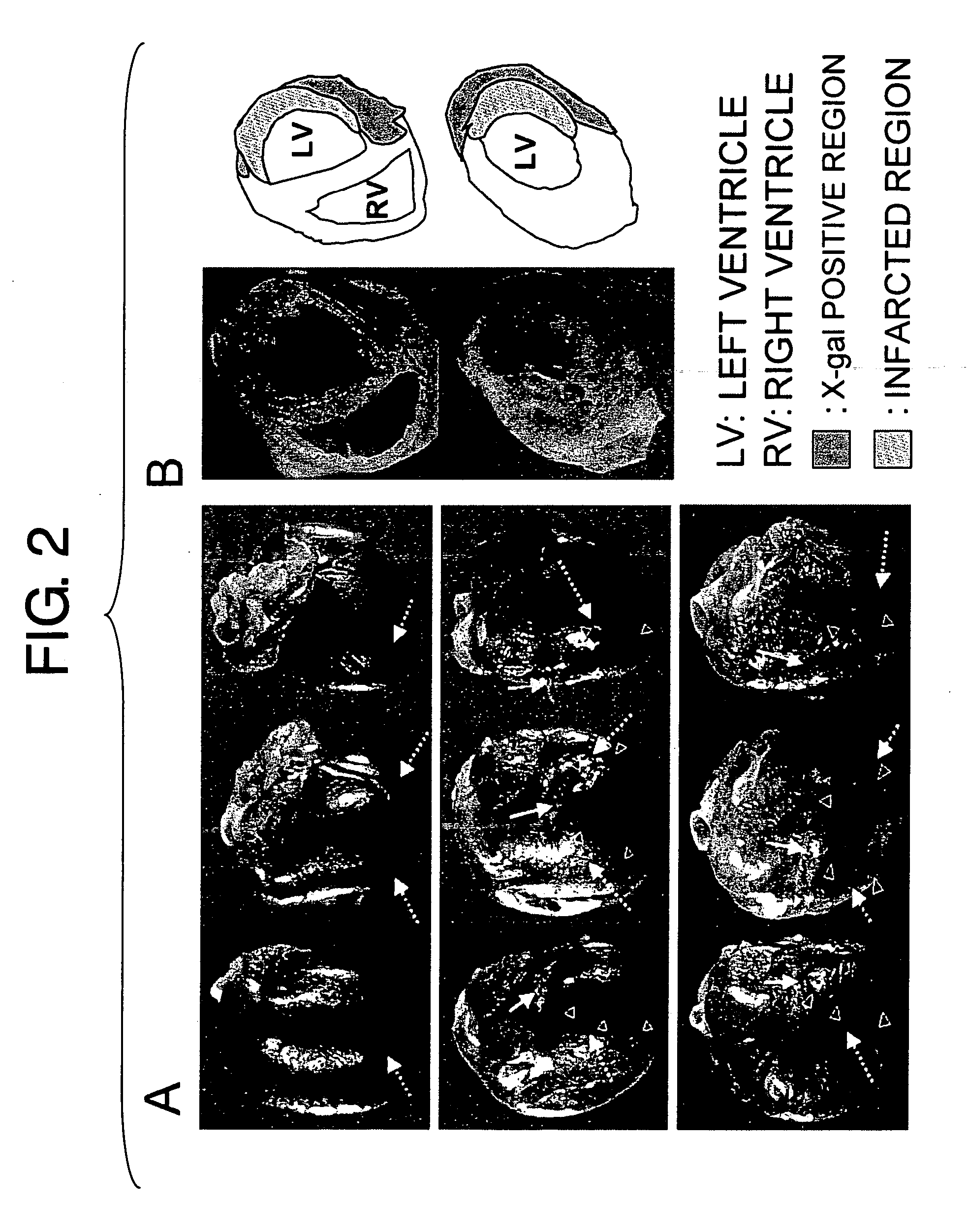Method for treating ischemic diseases
- Summary
- Abstract
- Description
- Claims
- Application Information
AI Technical Summary
Benefits of technology
Problems solved by technology
Method used
Image
Examples
example 1
Adenoviral VEGF and Ang1 Expression Vectors
[0113] Human VEGF gene was obtained by PCR cloning of cDNA derived from a human glioma cell line U251. The nucleotide sequence of the obtained VEGF gene was confirmed by BigDye Terminator method (Perkin-Elmer). Human Ang1 gene was PCR cloned from cDNA derived from human bone marrow cells, and the nucleotide sequence was confirmed by the same procedure described above. Comparison of the determined nucleotide sequence of the Ang1 gene with that registered under the accession number U83508 in GenBank suggested that they are identical, except that the nucleotide A at position 933 had been replaced with G Despite of the nucleotide substitution, the amino acid sequence of Ang1 protein is identical to that of U83508 in GenBank. The cloned VEGF and Ang1 cDNAs were individually inserted between the restriction sites EcoRI and BglII of a pCAcc vector (WO 02 / 100441; Ito., Y., et al. (2002) Mol Ther. 5: S162) derived from pCAGGS (Niwa, H. et al. (1991...
example 2
Adenoviral Vector-Mediated Gene Expression in Infarcted Hearts
[0115] Expression levels of foreign genes have been reported to be very low in infarcted hearts compared with normal hearts (Leor, J. et al. (1996) J Mol Cell Cardiol. 28: 2057-2067). Thus, prior to the start of the therapeutic experiment, it was examined whether genes introduced with an adenovirus were sufficiently expressed in rat models of myocardial infarction.
Preparation of a Myocardial Infarction Rat Model
[0116] A rat model of myocardial infarction was prepared according to the method of Pfeffer et al. (Pfeffer, M. A. et al. Cir. Res. 44: 503-512, 1979). Lewis rats (eight-week old, male, about 300 g body weight) were anesthetized by inhalation of diethyl ether and intraperitoneal injection of 70 mg / kg ketamine and 6 to 7 mg / kg xylazine, and then the rats were intubated. The rats were anesthetized by inhalation of 0.5% to 2.0% halothane under the conditions of: 200 to 250 ml minute ventilation, 3 ml tidal volume,...
example 3
Post-Myocardial Infarction Survival Rate After Introduction of the VEGF and Ang1 Genes
[0120] Since the gene expression from 1×1010 opu of adenovirus was clearly recognized in the infarcted cardiac muscle, the angiogenesis factor gene was used to treat the rat myocardial infarction model. The therapeutic effect of VEGF gene on myocardial infarction, previously shown to be effective for chronic myocardial ischemia, was examined at the same time. The survival rates in the untreated post-myocardial infarction group, adenovirus-administered control group, AxCAhVEGF-administered group, and AxCAhAng1-administered group were calculated four weeks after myocardial infarction. Rats that had died within 24 hours of the model preparation were eliminated in this calculation.
[0121] Ang1 expression in the hearts, into which the vector had been introduced, was also examined by RT-PCR (FIG. 3). The hearts were excised five days after the adenoviral vector-mediated gene introduction (1×1010 opu / hea...
PUM
| Property | Measurement | Unit |
|---|---|---|
| Therapeutic | aaaaa | aaaaa |
Abstract
Description
Claims
Application Information
 Login to View More
Login to View More - R&D
- Intellectual Property
- Life Sciences
- Materials
- Tech Scout
- Unparalleled Data Quality
- Higher Quality Content
- 60% Fewer Hallucinations
Browse by: Latest US Patents, China's latest patents, Technical Efficacy Thesaurus, Application Domain, Technology Topic, Popular Technical Reports.
© 2025 PatSnap. All rights reserved.Legal|Privacy policy|Modern Slavery Act Transparency Statement|Sitemap|About US| Contact US: help@patsnap.com



